Table of contents
- Inspection intervals – marketing gimmick or real advantage? Distance-time calculation
- MOTORRAD readers ride the most
- The motorcycle manufacturer specifies the oil change
- Annual inspection definitely makes sense
- Inspection intervals of the bestsellers
- “Specifications have to be met because of the guarantee claims”
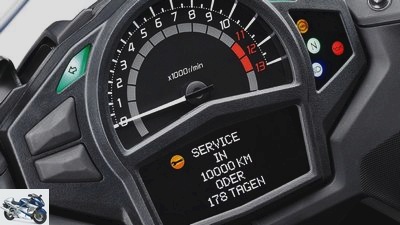
Kawasaki

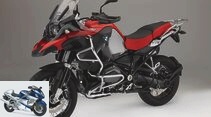
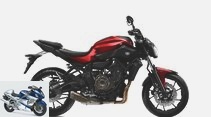
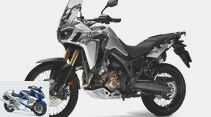
13th pictures
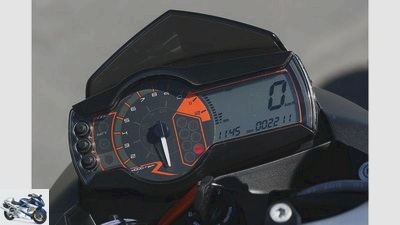
jkuenstle.de
1/13
The number of units sold in Germany from January to July 2016 (value in brackets) includes the brands BMW (18406), Yamaha (9866), Honda (9694), KTM (8615), Harley-Davidson (8609), Kawasaki (8182) , Ducati (4792), Suzuki (4260), Triumph (4006) and Husqvarna (1118) at the top. The bestsellers of the respective brand in the large inspection overview.
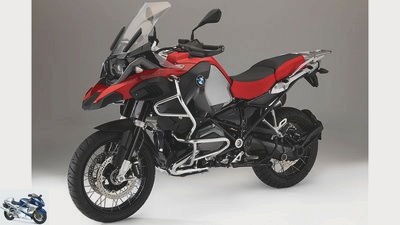
BMW
2/13
BMW R 1200 GS. Initial inspection / annual inspection: 500-1200km.
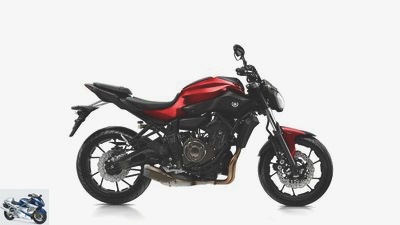
Yamaha
3/13
Yamaha MT-07. Initial inspection / annual inspection: 1000km.
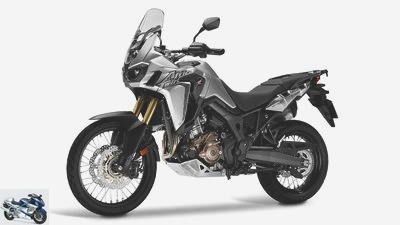
Honda
4/13
Honda CRF 1000 Africa Twin. Initial inspection / annual inspection: 1000km.
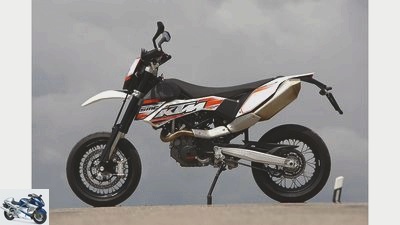
jkuenstle.de
5/13
KTM 690 SMC R. Initial inspection / annual inspection: 1000km.
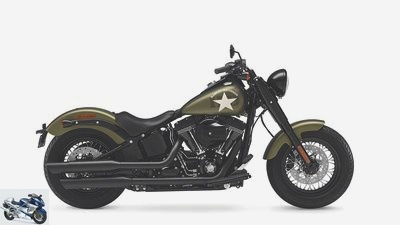
Harley-Davidson
6/13
Harley-Davidson Softail Slim. Initial inspection / annual inspection: 1600km.
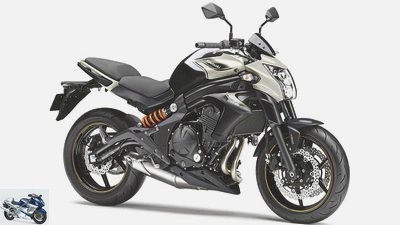
Kawasaki
7/13
kawasaki ER-6n / f. Initial inspection / annual inspection: 1000km.
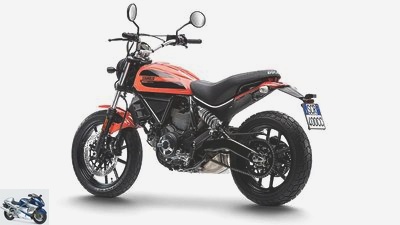
Ducati
8/13
Ducati scrambler. Initial inspection / annual inspection: 1000km.
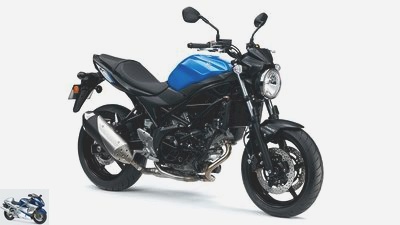
Suzuki
9/13
Suzuki SV 650. Initial inspection / annual inspection: 1000km.
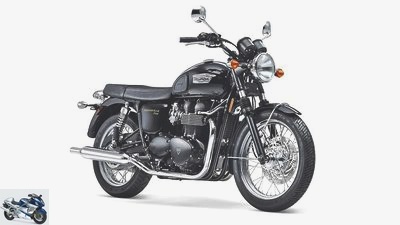
triumph
10/13
Triumph Bonneville T100. Initial inspection / annual inspection: 800km.
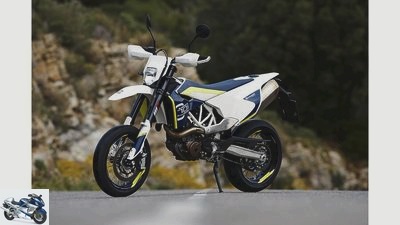
jkuenstle.de
11/13
Husqvarna 701 Supermoto. Initial inspection / annual inspection: 1000km.

jkuenstle.de
12/13
Karsten Schwers is a top tester at MOTORRAD.
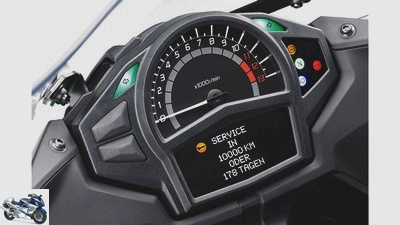
Kawasaki
13/13
Picture gallery: inspection intervals.
counselor
technology & future
Inspection intervals Marketing gimmick or real advantage
Inspection intervals – marketing gimmick or real advantage?
Distance-time calculation
The trend is towards longer kilometer intervals for maintenance. Is this a pure marketing tool or a tangible advantage for motorcycle buyers? As is often the case, the problem lies in the detail.
Brigitte Haschek
10/13/2016
MOTORRAD reader Helmut Blesing no longer understands the world. In April he got a brand new Yamaha MT-09 Tracer. According to the manufacturer, the touring-capable three-cylinder should be able to unwind 10,000 kilometers maintenance-free. Even so, the dealer says that the machine has to be inspected every year. Blesing wonders: “Who is the use of 10,000-kilometer or 15,000-kilometer intervals if maintenance has to be carried out every year, regardless of whether you have only driven 2,000 or 5,000 kilometers?”
Buy complete article
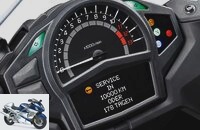
Inspection intervals – marketing gimmick or real advantage?
Distance-time calculation
4 pages) as PDF
€ 2.00
Buy now
Good question, next question: What is currently happening on the maintenance front? To get to the bottom of this, MOTORRAD carried out a survey of the brands with the highest number of new registrations (January to July 2016) in Germany. Conclusion: The industry trend is towards stretched service cycles (see table) – with some Ducati and KTM series it is even up to 15,000 kilometers. BMW introduced the so-called dynamic service concept almost ten years ago: the customer service indicator in the display – fed by the vehicle data – sounds the alarm as soon as the trip to the workshop is due. This has been the norm for cars for years. The on-board computer has the last word – no matter what inspection specifications are on paper according to the manufacturer.
MOTORRAD readers ride the most
But it is also a fact: the average annual mileage of bikers in this country has declined overall in the last 20 years. According to the Allensbach Institute for Demoscopy, it is currently 4,770 kilometers per year. The Kraftfahrt-Bundesamt (KBA), however, only shows just under 2,350 kilometers as the average mileage of motorcycles per year in Germany. The reason for this supposed contradiction: Statistics count, but do not calculate. The KBA survey is based on the mileage of vehicles read during the general inspection. Second or third motorcycles of the respective owner and the kilometers covered thus fall through the authorities grid. On the other hand, if you ask the MOTORRAD readers as the hard core of the ambitious bikers, the results are significantly higher mileage: they are stable around 7,600 kilometers per year, as the results of the polls in the readers’ choice of “Motorcycle of the Year” show.
Even this peak value among the core clientele is, however, a long way from what most motorcycle manufacturers have currently defined as the kilometer-dependent maintenance frequency. That may please the absolute frequent driver. With the two-wheelers, the annual mileage usually stays below the set maintenance points. That is why all brands require an annual review without any ifs or buts if the speedometer does not yet show the interval target. In terms of the scope of work, this is roughly comparable to a normal small inspection.
The motorcycle manufacturer specifies the oil change
An integral part of all manufacturers: an oil change, regardless of the kilometers driven. Completely exaggerated, as not only MOTORRAD top tester Karsten Schwers thinks. A KTM dealer also confirms this. Why this is so, he reveals behind closed doors: “Real money is made from oil.” The customer’s invoice is usually more than four times what has to be paid for in purchasing. Therefore, to denounce the workshops across the board as Raffkes and Gierschlunde, but this is not justified – after all, the requirement for annual oil changes comes from the motorcycle manufacturer. This can certainly be interpreted as a piece of sugar for the sales organization: Most brands give their dealers a certain amount of sales per machine sold, which can be achieved with spare parts, accessories and clothing as a whole. For example, a KTM buyer has to put 2,600 euros on the counter in order for the dealer to meet this requirement.
There are even more inconsistencies around the obligatory oil change: Sometimes the simultaneous oil filter change is in the specifications, for example at Harley-Davidson and Ducati. And not at all – for example with Honda’s Africa Twin or Yamaha’s bestseller MT-07. “That doesn’t make sense at all,” admits a Yamaha dealer quite self-critically. But the good man usually sticks to the factory specifications. The reason: “If there is only one item on the invoice that is not on the maintenance schedule, the customers sound the alarm.” He advises changing the filter at the same time, but is therefore in a bind. One can only say: Dear MT-07 drivers, the five or eight euros for the filter really doesn’t matter anymore.
Annual inspection definitely makes sense
Anyone who immerses themselves in the respective maintenance plans will more than once ask themselves the question of the sense or nonsense of the prescribed measures. In the Triumph Bonneville T 100, for example, the fuel hoses have to be replaced every four years – regardless of the mileage – costing around 250 euros. “A visual inspection would be enough for now,” admits a Triumph dealer frankly. He also does not really understand why, according to Triumph, the petrol filter should be due every 20,000 kilometers. “At Bonnie, the costs are still within reasonable limits at around 30 euros,” he says. With other Triumph models, however, you can get up to 90 euros.
So that no misunderstandings arise: an annual inspection definitely makes sense. You are simply better on your way if all safety-relevant components are checked before the start of the new season. And: Because more and more bikers own not just one, but two, three or more motorcycles, the number of standing damage is increasing. A typical example are fork seals. If the ravages of time have gnawed at them, one movement is enough and they tear. Not a particularly pleasant idea of having to slow down effectively with an oily front brake.
Inspection intervals of the bestsellers
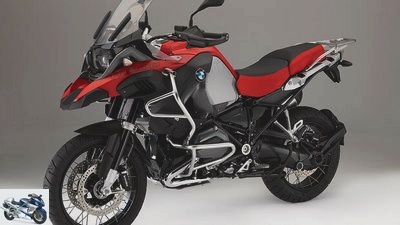
BMW
BMW R 1200 GS.
BMW R 1200 GS *
| kilometre | Working time in hours | |
| Initial inspection / annual inspection | 500-1,200 | |
| or at kilometers |
5,000
10,000
15,000
20,000
1.2
0.75
1.2
1.4
* Example at 5,000 km / year
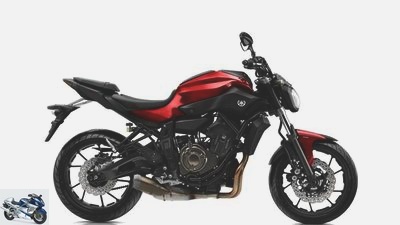
Yamaha
Yamaha MT-07.
Yamaha MT-07
| kilometre | Working time in hours | |
| Initial inspection / annual inspection | 1,000 | 1.3 / 1.6 |
| or at kilometers |
10,000
20,000
30,000
40,000
2
2.5
2
2.5
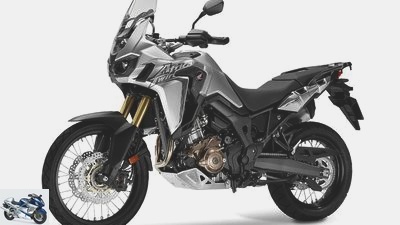
Honda
Honda CRF 1000 Africa Twin
Honda CRF 1000 Africa Twin
| kilometre | Working time in hours | |
| Initial inspection / annual inspection | 1,000 | 0.8 / 1.6 |
| or at kilometers |
12,000
24,000
36,000
48,000
1.6
3.1
1.6
3.1
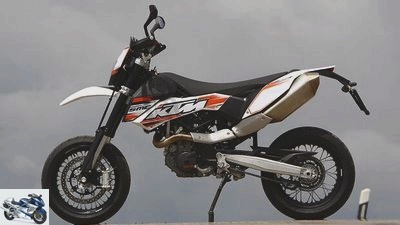
jkuenstle.de
KTM 690 SMC.
KTM 690 SMC
| kilometre | Working time in hours | |
| Initial inspection / annual inspection | 1,000 | 1.2 / 3.3 / 4.0 (every two years) |
| or at kilometers |
10,000 *
20,000
30,000
40,000
3.3
4.0
3.3
4.0
* or after every sporting activity
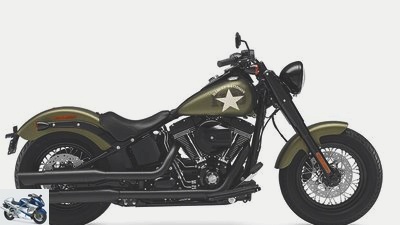
Harley-Davidson
Harley-Davidson Softail Slim.
Harley-Davidson Softail Slim
| kilometre | Working time in hours | |
| Initial inspection / annual inspection | 1,600 | 2.2 / 1.4 |
| or at kilometers |
8,000
16,000
24,000
32,000
1.4
2.1
1.4
2.3
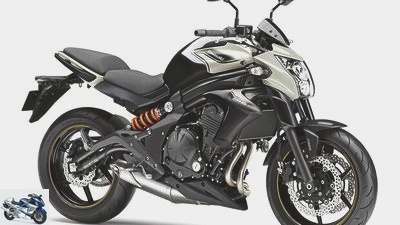
Kawasaki
Kawasaki ER-6n / f.
Kawasaki ER-6n / f
| kilometre | Working time in hours | |
| Initial inspection / annual inspection | 1,000 | 1.0-1.2 / 0.5 |
| or at kilometers |
6,000
12,000
18,000
24,000
0.5
1.5-1.8
0.8
2.0-2.2
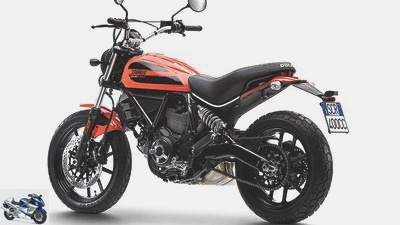
Ducati
Ducati scrambler.
Ducati scrambler
| kilometre | Working time in hours | |
| Initial inspection / annual inspection | 1,000 | 1.2 / 1.2 |
| or at kilometers |
12,000
24,000
36,000
48,000
3.2
4.5
3.2
4.5
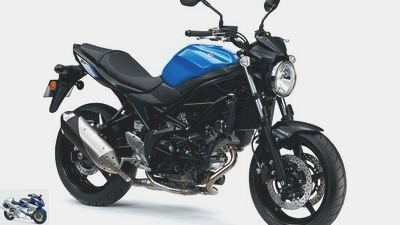
Suzuki
Suzuki SV 640.
Suzuki SV 640
| kilometre | Working time in hours | |
| Initial inspection / annual inspection | 1,000 | 1.4 / 1.6-1.8 |
| or at kilometers |
12,000
24,000
36,000
48,000
2.1
3.3
2.1
3.3
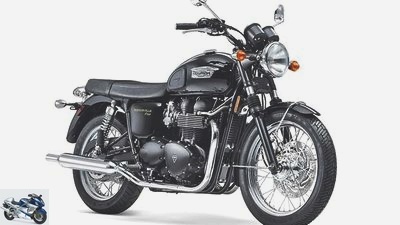
triumph
Triumph Bonneville T100.
Triumph Bonneville T100
| kilometre | Working time in hours | |
| Initial inspection / annual inspection | 800 | 1.2 / 1.2 |
| or at kilometers |
10,000
20,000
30,000
40,000
1.45
3.30
1.45
3.65
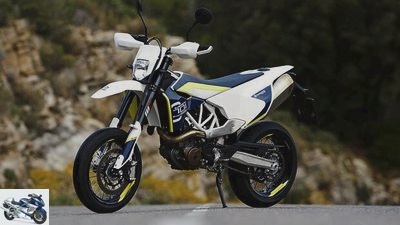
jkuenstle.de
Husqvarna 701 Supermoto.
Husqvarna 701 Supermoto
| kilometre | Working time in hours | |
| Initial inspection / annual inspection | 1,000 | 1.2 / 3.3 / 4.0 (every two years) |
| or at kilometers |
10,000 *
20,000
30,000
40,000
3.3
4.0
3.3
1.0
* or after every sporting activity
“Specifications have to be met because of the guarantee claims”

jkuenstle.de
Karsten Schwers is a top tester at MOTORRAD.
How the inspection intervals are taken into account in the MOTORRAD test scheme and what is up-to-date and useful from the perspective of the practitioner, tells us Top tester Karsten Schwers.
MOTORRAD awards a maximum of 20 points for the inspection costs in the 1000-point evaluation. Of this, up to ten points can be achieved for the inspection interval and for the corresponding guide times. For example, an interval of 10,000 kilometers gives eight out of ten points. Because of the differences, the hours are determined over a longer mileage. A high number of points can only be achieved in this chapter due to a long interval and short guide times. The inspection intervals are currently between 5,000 and 15,000 kilometers – depending on the make, model or year of manufacture. For the Japanese, only Yamaha have used long intervals so far.
In the meantime, however, a rethink has taken place, as the example of the newer Suzuki models shows. Europeans such as Triumph and Ducati already practice this. At KTM, the intervals are also increasingly being stretched. For me, inspection intervals of 10,000 kilometers or more are completely practical. Everything else is just too short and out of date. Not every vacation trip starts immediately after an inspection, and an extended trip through the Alps can quickly add up to a few thousand kilometers. In addition, the waiting times for an appointment in the workshop are usually longer in the summer months. You can bridge a summer better than taking shorter steps.
In terms of shelf life, intervals of 10,000 are sufficient. The fact that an oil change is due at every annual inspection is an exaggeration. Speaking of exaggeration: We were somewhat astonished when the complete brake lines including seals for the brake pistons had to be replaced after 48,000 kilometers in the MOTORCYCLE endurance test of the Kawasaki Z 1000. Cost: 2,500 euros. After just two years, they were still fully functional. The crux of the matter: Because of possible warranty claims, the owner must adhere to the manufacturer’s specifications. However, if 48,000 kilometers are only achieved after 16 years with an annual output of only 3,000 kilometers, this maintenance work is of course absolutely sensible. For frequent drivers, however, a visual inspection would be sufficient in shorter sections.
Related articles
-
Service check: inspection costs
Harley-Davidson motorcycles Service check: inspection costs Overview of inspection costs What does the professional service cost? Whether for warranty…
-
Workshop – screwdriver tip for the inspection
Ralf Petersen 15th pictures Ralf Petersen 1/15 Every motorcycle must be serviced regularly if it is to function properly. Ralf Petersen 2/15 What is…
-
Screwdriver tip for the check before the main inspection
Ralf Petersen 14th pictures Ralf Petersen 1/14 Don’t forget: papers, ABEs, tire approvals and a key for the steering lock. Ralf Petersen 2/14 Only with…
-
Time limits for motorcycle repairs workshop
markus-jahn.com counselor traffic & business Time limits for motorcycle repairs workshop Timing for motorcycle repairs Over time it gets annoying When it…
-
This is how it works: Remove rust from the tank
counselor workshop This is how it works: Remove rust from the tank This is how it works: derust the tank How do I get rid of the rust? Rotten fuel…
-
Triumph guarantee: four years now without restrictions
triumph counselor traffic & business Triumph guarantee: four years now without restrictions Triumph upgrades warranty Four years now without restrictions…
-
Used advice Honda ST 1100 Pan European
Drawing: Honda counselor Used purchase Used advice Honda ST 1100 Pan European Used advice Honda ST 1100 Pan European Honda ST 1100 Pan European The Honda…
-
archive motorcycles Motorcycle review in decades Motorcycle review in decades Motorcycles that shaped epochs New year, time to look back. But not…
-
20 years of triumph in Hinckley-England
archive counselor traffic & business 20 years of triumph in Hinckley / England Spotlight: History of Triumph 20 years of triumph in Hinckley / England…
-
Screwdriver tip – care and inspection of the suspension struts
Photo: Ralf Petersen 14th pictures Ralf Petersen 1/14 1: Classic, beautiful and easy to adjust: stereo shock absorbers. Ralf Petersen 2/14 2: Efficient -…